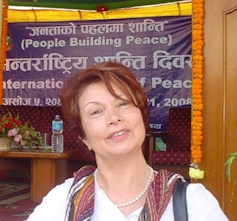Martha Llanos, Peru
 In my varied career, including my time as the first UNICEF Regional Advisor for Latin America and the Caribbean, I have worked for the rights of the child in Peru and around the world.
In my varied career, including my time as the first UNICEF Regional Advisor for Latin America and the Caribbean, I have worked for the rights of the child in Peru and around the world.
Last year I had a wonderful time sharing Peace Ambassadors workshops with women and girls from India, Nepal, and Greece.
I just completed three presentations at the International Conference on Human Development that took place in Lima.
Now I am preparing to journey to Slovenia and Croatia to work on intercultural issues and coping and resilience in emergency situations.
All my work is peace education. The heart of peace education is understanding people’s lives, dreams, cultures, and practices and appreciating them in whatever contributions they make to society.
Peace education encompasses flexibility, creativity, discovery, and finding value in every way that collectivity can be built for the common good. Values such as cooperation, trust, solidarity, and respect are essential for peace building.
As Mahatma Gandhi said:
If we want true peace in the world, we shall have to start with the children. We will not have peace in the world if we continue to violate children’s rights.
To build a global culture of peace we must build a collective vision in which the culture of peace features presented in the UNESCO Manifesto are expressed in our everyday life:
1. Respect all life. Respect the life and dignity of each human being without discrimination or prejudice.
2. Reject violence. Practice active nonviolence, rejecting violence in all its forms: physical, sexual, psychological, economic, and social, in particular towards the most deprived and vulnerable, children and women.
3. Share with others. Share time and material resources to put an end to exclusion, injustice, and political and economic oppression.
4. Listen to understand. Defend freedom of expression and cultural diversity, giving preference always to dialogue and listening without engaging in fanaticism, defamation, or the rejection of others.
5. Preserve the planet. Promote responsible development practices that respect all forms of life and preserve the balance of nature.
6. Rediscover solidarity. Contribute to community development, with full participation of women and respect for democratic principles.
Cultivating peace is like cultivating plants. Good seeds are rooted in a fertile soil and can only flourish with love and care.
We see great opportunities even in the midst of the most difficult situations. To start in the early years of life, what we in Peru call primera enfancia, brings a wonderful possibility for peace to be constructed.
There is such potential in every human being that even with the tremendous violence in today’s world, there are examples of forgiveness, reconciliation, and looking into a better future that restore trust in human beings.
As a speaker, sharing worldwide stories of human greatness, and as a storyteller and Biodancer, I spread peace education through the arts.
As long as human hearts can connect and love, especially during such times as these, there is hope. (Naba Saleem Hamid)
September 28th, 2009
PEACE X PEACE: Your Voice from the Frontline
Connecticut Avenue, NW, Suite #400, Washington DC, 20009
Photo credit: Patricia Smith Melton